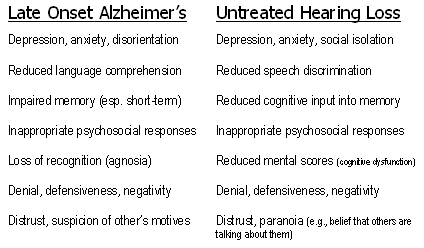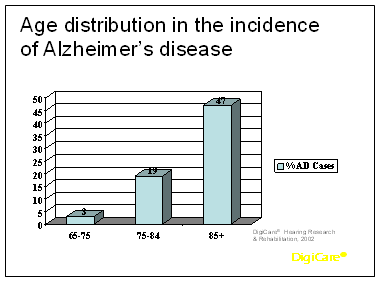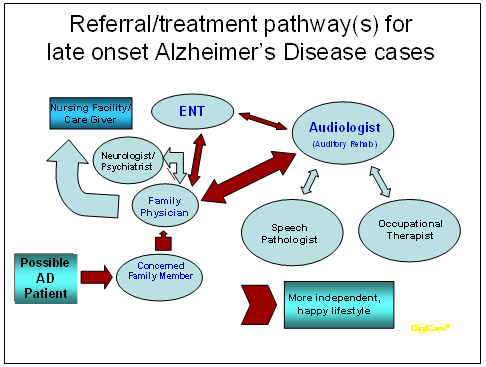"Hearing impairment is an invisible handicap, yet its effects upon one's personal health, happiness, and personal well-being are very real."
Vignette:
The adult children of 87 year-old Anna Smith were concerned about her mental health. She lived alone. Although no major mishaps occurred, they were concerned she was becoming reclusive and depressed. At family gatherings she kept to the side and didn't' participate in conversations. Family members attempted to include her, but her responses were inappropriate and off-subject. Family members were embarrassed to keep trying. Her family physician placed her on anti-depressant medication. The medication caused her to be anxious and she stayed awake all hours. Anti-anxiety medication was added. She was soon referred to a local psychiatrist. The psychiatrist administered the Mini Mental State Examination (MMSE) battery, on which she scored 10 errors, indicating moderate Alzheimer's disease (AD). Her children were distraught over the diagnoses, but concluded based on their observations and the doctors,' that Alzheimer's was apparent. Plans were made to take Power of Attorney for her real and personal assets and she was admitted to a nearby nursing home.
Introduction:
An ongoing and pervasive lack of public and professional awareness regarding the importance of ruling out hearing loss and auditory disorders prior to diagnosing Alzheimer's disease is apparent.
For example, in The Caregiver Handbook (Area Agency on Aging, 2004), an otherwise excellent publication regarding management advice and related information for those suffering with dementia, there is no mention of audiology, audiologists, hearing aids, hearing specialists, hearing impairment or the cognitive effects of undiagnosed and uncorrected hearing loss. The section titled "Communicating with someone who has dementia" reads just like instructions for communicating with someone with severe hearing impairment.
Likewise, graduate-level textbooks dealing with memory, cognition, geriatrics and eldercare fail to relate the link between cognitive function in older adults and auditory disorders (Schultz & Salthouse, 1999; Matlin, 2002). From public to professional, from diagnosis to treatment, and from government regulatory agencies to research institutions, the likely and reasonable examination and exploration of hearing loss, as an undiagnosed, pre-existing condition in patient's suspected of having Alzheimer's disease, appears non-existent.
Alzheimer's Disease: At Best, a Difficult-to-Diagnose Condition
Alzheimer's disease is a degenerative form of mental illness. Symptoms of Alzheimer's disease (AD) can be caused by many independent and over-lapping factors. Alzheimer's-like symptoms can be attributed to disease-causing genetic mutations, subdural hematoma, chronic hypothermia, vitamin B-12 deficiency, adverse drug interactions, mercury or manganese poison, Huntington's disease, alcoholism, and Mad Cow disease (Rait et al, 2005; Adviware, 2005; Blackwell et al, 2004; Lawrence et al, 2003) and hearing impairment.
AD is enormously difficult to diagnose for even the best trained professionals. In 1996, researchers at Columbia-Presbyterian Hospital, in a post-mortem investigation of patients previously diagnosed with AD, found a 45% misdiagnosis rate (Alzheimer's Foundation, 2005). In addition, normal age-related cognitive changes have been implicated in cases of misdiagnosis and overdiagnosis of AD, signaling the need for better, more accessible, cost-effective diagnostic methodologies (National Institute on Aging, 2002).
But, just as an auditory evaluation was lacking in the vignette above, it is absent in most cases of AD (Chartrand, 2001b; Ullman et al, 1989; Peters, Potter, and Scholar, 1988). Other cognitive conditions, such as depression, anxiety and anti-social behaviors caused by previously undiagnosed and uncorrected hearing loss have been documented in the literature (Chartrand, 2001a).
In the above vignette, which represents a typical scenario, hearing status was not considered, or was disregarded by family and health professionals, each of whom made decisions critical to the well-being of Mrs. Anna Smith.
The most commonly used screening examinations, the Mini Mental State Examination (MMSE), the Sternberg Memory Scan and California Verbal Learning Test, are all administered verbally (i.e. using spoken words) to older adults (Dumont and Hagberg, 1994). These tests assume normal hearing acuity and normal central auditory processing ability—two separate and distinct areas of concern—in a demographic age-group fraught with auditory disorders.
The thesis of this paper is that any/all thorough and comprehensive clinical assessments regarding cognitive function in older adults must begin with a thorough and comprehensive audiometric evaluation, by a licensed audiologist. Furthermore, if an auditory deficit is found, aural rehabilitation should be facilitated before a true and valid assessment of cognitive function can be rendered (see Figure 1).
Figure 1. Symptom analysis and comparison between moderate Alzheimer's disease and untreated hearing loss.
Figure 2 (below) demonstrates the prevalence of hearing impairment in the different age-groups. Hearing impairment becomes quite concentrated in the older population. For example, 36% of the population between 65 and 84 years of age have hearing loss, whereas 66% or more of those age 85 years and above have hearing loss (Aural Rehab Concepts, 2000). The aging of America continues unabated, with those 85 years and older making up the fastest growing demographic age group (U.S. Census Bureau, 2005).
Figure 2. Prevalence of hearing impairment across age-group populations.
The prevalence of hearing loss and AD in the general population track similarly in age-group distribution (see Figure 3 below).
Figure 3. Prevalence of AD in the various age-groups.
Co-Morbidity Probability:
As is evidenced above (see figures 2 and 3) as aging occurs, the probability and incidence of AD and hearing loss increase. Importantly, these are not mutually exclusive factors. The probability that the two conditions are co-morbid contributors to an individual's possible disability increase with age.
Mental health professionals should ascertain the auditory status of the older adult before deriving a diagnosis or proceeding with treatment of/for cognitive/memory disorders.
Possible Referral Path:
To accomplish a thorough and comprehensive audiometric evaluation on suspected Alzheimer's disease patients, the following steps may serve as a template:
- Possible AD suspicion by family member.
- Family member urges primary care physician (PCP) evaluation.
- PCP evaluates overall health and refers to audiologist for comprehensive
audiometric evaluation (acuity tests and auditory processing analysis). - Audiologist reports findings to PCP and initiates amplification and aural rehabilitation for appropriate patients (hearing aids, assistive listening devices, alerting devices, classroom or group AR sessions with family members and significant others).
- Patient is re-evaluated by PCP after appropriate audiologic management and after adaptation period (60 to 90 days).

Summary:
Each situation and each patient is unique and no one model serves to address all possible presentations, management options and outcomes.
However, the point has been made that many potential AD patients, particularly the most aged, are highly likely to have demonstrable hearing loss requiring diagnostic audiology tests and audiologic intervention. Attending to audiologic issues prior to diagnosing AD, makes intuitive sense and potentially leads to far better outcomes for all concerned.
 About the author...
About the author...Max Stanley Chartrand serves as managing director for DigiCare Hearing Research & Rehabilitation. He is profoundly deaf and utilizes a cochlear implant. As a widely published author and educator in the hearing field he brings unique insights into the assessment and treatment of the hearing impaired. Contact: (719)676-3277 or by email at www.digicare.org
Selected Audiology Online HYPERLINKS to information on Alzheimer's Disease:
/interviews/interview-with-stephen-bartels-m-1608
www.audiologyonline.com/articles/arc_disp.asp?article_id=400
www.audiologyonline.com/news/displaynews.asp?news_id=1233
www.audiologyonline.com/news/displaynews.asp?news_id=778
www.audiologyonline.com/articles/arc_disp.asp?article_id=352
Recommended Readings and References:
Adviware, (2005). Misdiagnosis of Alzheimer's Disease. Retrieved on May 28, 2005, from www.wrongdiagnosis.com/a/alzheimers_disease/misdiag.htm
Alzheimer's Foundation, (2005). Cognitive Impairment Common in Older People and a Risk Factor for Dementia. Retrieved on May 29, 2005, from www.alzfoundation.com/news2.htm
Area Agency on Aging, (2004). Caregiver Handbook: For caregivers of older adults in Fremont, Chaffee, Custer, and Lake Counties. Upper Arkansas Area Council of Governments, provided by Aging Services Division of the Denver Regional Council of Governments.
Aural Rehab Concepts, (2000). Prevalence of hearing loss by age-group in the United States. Retrieved on May 27, 2005, from www.digicare.org
Blackwell, A.D., Sahakian, B.J., Vesey, R., Semple, J.M., Robbins, T.W., and Hodges, J.R., (2004). Detecting Dementia: Novel Neuropsychological Markers of Preclinical Alzheimer's Disease. Dementia and Geriatric Cognitive Disorders, 17: 42-48.
Chartrand, M.S., (2005, April 18). Identifying neuroreflexes of the external ear canal. Audiology Online, retrieved on May 29, 2005 from www.audiologyonline.com
Chartrand, M.S., and Chartrand, G.A., (2004). If a Tree Fell in the Forest: What's Really HOldiong Back the Market? The Hearing Review, January, pp. 44-47.
Chartrand, M.S., (2001B, November). Hearing Health Care and Alzheimer's Disease: The role of hearing healthcare in treating patients with Alzheimer's disease. The Hearing Review, pp.26-29.
Chartrand, M.S., (2001A, January-February). Cognitive Manifestations in Unmitigated Hearing Loss. The Hearing Professional, pp. 11-13.
Chartrand, M.S., (1995, April-May). Aging, Dementia, and Hearing Health. Hearing Health, pp. 22-24.
Dumont, R., and Hagberg, C., (1994). Kaufman Adolescent and Adult Intelligence Test (KAIT): Test Review. Journal of Psychoeducational Assessment, 12(2): 190-196.
Folstein, M.F., Folstein, S.E., McHugh, P.R., (1975). Mini-mental state: A practical method for grading the cognitive state of patients for the clinician. Journal of Psychiatric Research, 12, pp. 189-198.
Gatehouse, S., and Killion, M., (1993). HABRAT: Hearing Aid Brain Rewiring Accommodation Time. Hearing Instruments, 44(10): 29-32.
Gelfand, S. A. (2003). Tri-word presentations with phonemic scoring for practical high-reliability speech recognition assessment. J Speech Lang Hear Res, 46(2), 405-412.
Gimsing, S. (1990). Word recognition in presbyacusis. Scand Audiol, 19(4), 207-211.
Gordon-Salant, S., and Fitzgibbons, P.J. (2001). Sources of age-related recognition difficulty for time-compressed speech. Journal of Speech, Language, and Hearing Research, 44: 709.
Halpern, H., Keith, R. L., & Darley, F. L. (1976). Phonemic behavior of aphasic subjects without dysarthria or apraxia of speech. Cortex, 12(4), 365-372.
Interview with Jay McSpaden, PH.D. (2002). Audiology Online, July 8, 2002, www.audiologyonline.com/interview/displayarchives.asp?interview_id=129
Jerger, J., Jerger, S., Oliver, T., & Pirozzolo, F. (1989). Speech understanding in the elderly. Ear and Hearing, 10, 79-89.
Kalayam, B., Meyers, B. S., Kakuma, T., Alexopoulos, G. S., Young, R. C., Solomon, S., et al. (1995). Age at onset of geriatric depression and sensorineural hearing deficits. Biol Psychiatry, 38(10), 649-658.
Kapteyn, T. S. (1982). Rehabilitation possibilities in presbycusis [Article in Dutch]. Tijdschr Gerontol Geriatr, 13(5), 179-185.
Kaufman, A.S., and Kaufman, N.L., (1992). Kaufman Adolescent and Adult Intelligence Test. Retrieved on May 5, 2005, from alpha.fdu.edu/psychology/kait.htm
Kruger, B., Bumm, P., and Lang, E. (1981). Speech audiometry in advanced age-differentiating between the elements of primary and secondary presbyacusis (author's translation)[Article in German]. Laryngol Rhinol Otol (Stuttg), 60(3), 130-134.
Lawrence, J.M., Davidoff, D.A., Katt-Lloyd, and Connell, A. (2003, August). Is large-scale community memory screening feasible? Experience from a a regional memory screening day. Journal of the American Geriatrics Society, 51(8): 1072-1083.
Kruschke, J.K., (2004). Cognitive Psychology. University of Indiana, retrieved on May 11, 2005, from www.indiana.edu/-jkkteach/P335/exam3qa.html
Lawrence, J.M., Matlin, M.W., (2002). Cognition, (5th ed.). NY:Wiley, ISBN# 0470002212.
National Institute on Aging, (2002). Progress Report on Alzheimer's Disease 2001. Retrieved on May 25, 2005, from www.alzinfo.org/research/diagnosis/default.aspx
Novak, R. E., & Anderson, C. V. (1982b). Differentiation of types of presbycusis using the masking-level difference. J Speech Hear Res. 1982 Dec;25(4):504-8.
Pearlman, R. C. (1982). Presbycusis: the need for a clinical definition. Am J Otol, 3(3), 183-186.
Peters, C., Potter, J., and Scholar, S., (1988). Hearing impairment as a predictor of cognitive decline in dementia. The Journal of the American Geriatric Society, 36: 981-986.
Rait, G., Fletcher, A., Smeeth, L., Brayne, C., g, S., Nunes, M., Breeze, E., Ng, E.S, Bulpitt, C.J., Jones, D., and Tulloch, A.J., (2005, May). Prevalence of cognitive impairment, results from the MRC trial of assessment and management of older people in the community. Age and Ageing (Oxford), 34(3):242-273.
Reinecke, M. (1977). Double-blind comparison of vincamine and placebo in patients with presbyacusis (author's transl) [Article in German]. Arzneimittelforschung., 27(6a), 1294-1298.
Rizzo, S. R. J., & Gutnick, H. N. (1991). Cochlear versus retrocochlear presbyacusis: clinical correlates. Ear Hear, 12(1), 61-63.
Schuknecht, H. (1974). Pathology of the Ear. Cambridge, MA: Harvard University Press.
Schultz, R., and Salthouse, T., (1999). Adult Development and Aging, (3rd edition). Upper Saddle River, NY: Three Rivers Press. ISBN 0517882124.
Stach, B., Spretnjak, M., & Jerger, J. (1990). The prevalence of central presbycusis in a clinical population. Journal of the American Academy of Audiology, 1, 109-115.
Stary, A., (2002, February). Aging and Hearing Loss. Stephen F. Austin State University, retrieved on May 4, 2005, from hubel.sfasu.edu/courseinfo/SL02/aging_and_hearing_loss.htm
Surr, R. K. (1977). Effect of age on clinical hearing aid evaluation results. J Am Audiol Soc, 3(1), 1-5.
Tyberghein, J. (1996). Presbycusis and phonemic regression. Acta Otorhinolaryngol Belg, 50(2), 85-90.
Ullman, R., Larson, E., Rees, T., Koepsell, T., Duckert, L., (1989). Relationship of hearing impairment to dementia and cognitive function in older adults. The Journal of the American Medical Association, 261: 1916-1919.
U.S. Census Bureau, (2005). Interim Census Report 2005. Washington, D.C.
Welsh, L. W., & Welsh, J. J. (1985). Central presbycusis. Laryngoscope, 95(128-136).
Willot, J.F., (1981). Aging and the Auditory System: Anatomy, Physiology, and Psychophysics. San Diego: Singular Publishing Group, Inc.

